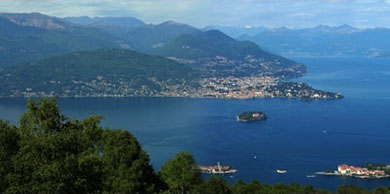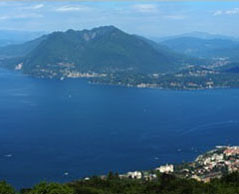 |
|
THE SURROUDING AREAS The region of Lake Maggiore from Arona in the southwest all the way to Cannobio near the Swiss border is also known as the Verbano region. It is a vast and diverse area overflowing with both natural and historic wonders. From the Valle dell’Ossola to Verbania to Cusio and all the places in between there is so much to explore.
VERBANO
Verbano is the region from Arona in the southwest to Cannobio near the Swiss border, and it is the area that has, for two centuries, been most frequented by tourists, artists, writers, politicians and jet-setters. The hotels have been witness to many historic events, and the lake has been described in the pages of famous writers. On her shores are built the most beautiful villas, recalling times in which the nobility and wealthy chose the Piedmont lakeside for their summer holidays. The beauty of the scenery is not the only attraction. There is also the respect for nature, evidenced by the number of parks that have been established, the discreet and cordial hospitality of the people of the Verbano region, and the abundance of art and architecture. From S. Carlone of Arona and all the way to the Swiss border, monuments and churches offer a rich array of artistic and architectural treasures to discover. A few examples will be more than sufficient to illustrate this. The powerful and colossal statue of S. Carlone that dominates Arona; to the north at Lesa the church of S. Sebastiano, a well preserved Romanesque structure, the church of S. Maria at Belgirate with its frescoes dating from the 1400’s, the splendid Palazzo Borromeo on Isola Bella, the Romanesque church of SS Gervasio and Protasio at Baveno, the religious edifices and the palace at Verbania, the Sacred Mountain of Ghiffa, the castles of Cannero, and the medieval traces that are still noticeable in the heart of Cannobio. Art is not found only in the monuments, frescoes and preserved canvases in these religious buildings; there is so much more to see in the many museums that are part of the rich cultural landscape of this territory. For example, there is the Museo del Paesaggio (Museum of the Landscape) di Verbania, and some very curious museums such as the Museo del Cappello di Ghiffa (museum of hats) and the Museo del’Ombrello di Gignese (museum of umbrellas).
|
| |
OSSOLA VALLEY
Ossola is the area high in the mountains with views extending to distant horizons; it is an area of old walser traditions. Here nature is the real star, offering itself unspoiled to the tourist. Skiing and all winter sports abound on runs that meet the needs of all from beginner to expert. And in the warm months there are hiking trails and campgrounds for those seeking solitude in the mountains. There is the National Park of the Val Grande whose goal it is to preserve the flora and fauna of the Alps. There are museums which recall the traditional work of the inhabitants of the region in times past, miners and chimney sweeps, and there are historic villages and churches to visit, such as Vogogna and the Parish Church of Villadossola. Other sights worth noting are the palaces of Domodossola, the Parish Church of S. Gaudenzio in Baceno, the walser features of the Formazza Valley and the “jewels” of the Vigezzo Valley, especially the Sanctuary of the Madonna del Sangue di Re which is the destination of pilgrims coming from all over Europe. The Ossola area has been able to preserve much of its old traditions and folklore, such as the living crib scenes, the popular parades of the Militas in Bannio Anzino and Calasca Castiglione. Old religious festivals such as Candlemas and the processions of the Autani are being revived as are festivals linked to walser history, such as Pomattertag and Advent’s Garland.
|
| |
CUSIO
There is a different atmosphere in the Cusio area. The feeling is intimate and rarified, especially in places like Orta with its small square resembling a living room and its houses built between the Middle Ages and the 18th century, as well as on S. Giulio island and at the Basilica of the same name. There are several attractions in the Cusio area for the tourist who is looking for something a little different. Visit Omegna with its Middle Age feel, the Valstrona with its woodworkings, the western side of the lake which is overlooked by the church of the Madonna del Sasso, and the important picture gallery of the Calderara Foundation. Don’t overlook the curious Museums of Ethnography and of musical instruments and the equally curious Museo del Rubinetto (museum of the water tap). For those interested in sights of a religious nature there are ancient sanctuaries such as Madonna di Luciago, the Bocciola and S. Salvatore, religious buildings dating back to the year 1000, and numerous works of treasured art in churches. Art, nature and spirituality are combined on the Sacro Monte of Orta with its famous wood statues and the Natural Reserve of Monte Mesma. The respect and care for the environment is evident everywhere in the Vergante area, all the way up to the top of Mottarone, from where on a clear day seven lakes can be seen and admired. There are many small holiday resorts in the Cusio area, specializing in offering tourists a pleasant stay in close contact with nature, handicrafts, culture, sports and good food. |
| |
|
|
.gif)


.gif)

